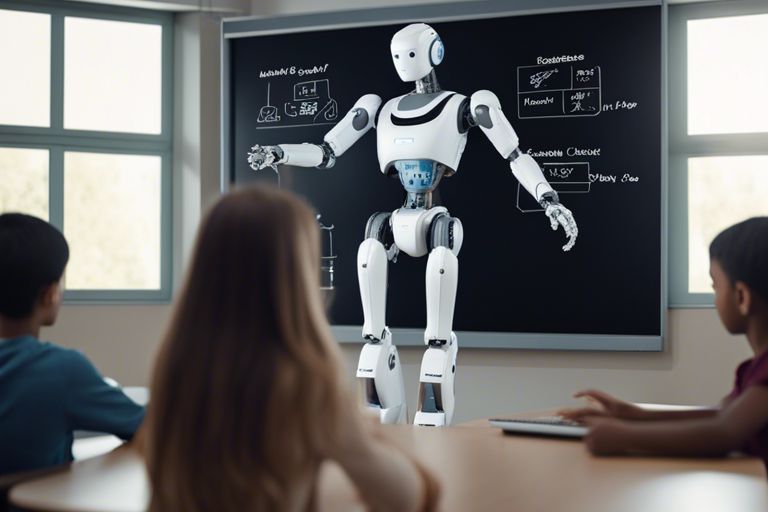It’s no secret that AI tools have revolutionized the way we approach education, and teachers can now harness the power of artificial intelligence to create more engaging and effective lesson plans for their students. By incorporating AI into their teaching strategies, educators can personalize learning, tailor instruction to individual student needs, and increase student engagement in the classroom.
The Need for Engaging Lesson Plans
The Challenge of Captivating Students
With the ever-increasing distractions and shortened attention spans of students in today’s digital age, teachers face a significant challenge in capturing and maintaining their students’ focus during lessons. Traditional teaching methods often fail to engage students effectively, resulting in disinterest, lack of participation, and ultimately, poor learning outcomes.
The Importance of Student Engagement
Student engagement is a crucial factor in the success of any educational program. Engaged students are more likely to be motivated, participate actively in class, and retain knowledge better. When students are actively involved in the learning process, they are more likely to develop critical thinking skills, problem-solving abilities, and a deeper understanding of the subject matter.
Understanding the significance of student engagement is necessary for educators looking to create effective lesson plans that resonate with their students. By incorporating interactive and innovative teaching methods, teachers can foster a more engaging learning environment, where students are eager to participate and learn.
What Are AI Tools for Teachers?
Definition and Overview
Some of the most advanced technologies shaping the future of education are AI tools for teachers. These tools utilize artificial intelligence to assist educators in various aspects of their work, from lesson planning to student assessments, ultimately enhancing the learning experience.
Types of AI Tools for Education
An crucial aspect of AI tools for teachers is the variety of applications available to enhance the teaching and learning process. AI tools for education can be categorized into different types, including:
- Virtual tutors: These tools provide personalized learning experiences for students, offering feedback and guidance.
- Smart content: AI tools can analyze and adapt educational materials to suit individual learning styles.
- Assessment tools: These tools help teachers evaluate student performance efficiently and effectively.
- Classroom management: AI tools can assist in organizing classroom activities and schedules.
- Language processing: Some AI tools aid in language learning by providing translation services and phonetic practice.
Recognizing the potential of these AI tools in revolutionizing education is crucial for educators looking to adapt to modern teaching methodologies.
| Virtual tutors | Personalized learning experiences with tailored feedback |
| Smart content | Adaptive educational materials based on learning styles |
| Assessment tools | Efficient ways to evaluate student performance |
| Classroom management | Tools to organize activities and schedules |
| Language processing | Support for language learning through translation and phonetic practice |

The Role of AI Tools in Enhancing Lesson Plans
Personalization and Differentiation
The tools provided by Artificial Intelligence can significantly enhance lesson plans by offering personalized and differentiated learning experiences for students. AI algorithms can analyze students’ learning styles, preferences, and performance data to create tailored lesson plans that meet individual needs. By incorporating AI tools, educators can better address the diverse needs of their students, ensuring that each learner receives content at an appropriate pace and level.
Automating Grading and Feedback
Enhance the efficiency of lesson planning by automating grading and providing instant feedback using AI tools. These tools can quickly evaluate student responses, grade assignments, and generate detailed feedback based on predefined criteria. By automating these tasks, teachers can save time on grading, allowing them to focus more on developing engaging lesson materials and providing additional support to students.
Understanding the intricacies of automating grading and feedback with AI tools is necessary to ensure accuracy and fairness in assessment. Educators must establish clear guidelines and parameters for the AI systems to follow, as well as regularly monitor and adjust the algorithms to maintain their effectiveness.
Identifying Learning Objectives with AI
Despite the advancements in technology, identifying learning objectives remains a critical task for educators. AI tools can assist teachers in this process by analyzing the specific needs of students and providing personalized recommendations for learning objectives.
Aligning Objectives with Curriculum Standards
Objectives: One of the key benefits of using AI tools for identifying learning objectives is the ability to align them with curriculum standards. AI can quickly cross-reference the desired outcomes of a lesson with specific standards, ensuring that teachers meet educational guidelines effectively.
Creating Measurable and Achievable Goals
Aligning: When aligning learning objectives with curriculum standards, it is important to create goals that are both measurable and achievable. AI tools can analyze the complexity of objectives and provide insights into whether they are realistic within the given timeframe.
Creating: By utilizing AI tools to create measurable and achievable goals, teachers can ensure that their lesson plans are effective and targeted towards specific learning outcomes. This not only enhances student engagement but also streamlines the teaching process, saving valuable time for educators.
Designing Engaging Lesson Activities with AI
For teachers looking to create engaging lesson plans, AI tools are a valuable resource that can enhance the learning experience for students. By incorporating AI into lesson activities, educators can create immersive and interactive experiences that cater to different learning styles and interests.
Simulations and Virtual Field Trips
With AI-powered simulations and virtual field trips, teachers can take their students on immersive journeys without ever leaving the classroom. These tools allow students to explore different environments, conduct experiments, and engage in hands-on activities that enhance their understanding of complex concepts.
Interactive Quizzes and Games
An exciting way to engage students is through interactive quizzes and games powered by AI. These tools can personalize the learning experience by adapting questions based on the student’s performance, providing instant feedback, and motivating them to improve.
Games
Interactive quizzes and games not only make learning fun but also help students retain information more effectively. By incorporating gamification elements into lesson activities, teachers can create a dynamic and engaging learning environment that promotes active participation and critical thinking.
Creating Adaptive Assessments with AI
Real-time Feedback and Progress Tracking
After designing engaging lesson plans using AI tools, teachers can leverage AI for creating adaptive assessments. AI technologies can provide real-time feedback to students, allowing them to track their progress instantly. This immediate feedback loop enables students to identify their strengths and weaknesses promptly, fostering a more personalized learning experience.
Identifying Knowledge Gaps and Areas for Improvement
An imperative feature of using AI for adaptive assessments is the capability to identify knowledge gaps and areas for improvement. AI algorithms analyze student performance data to pinpoint specific areas where students may be struggling. This detailed insight helps teachers tailor their instruction to address individual student needs more effectively.
Creating adaptive assessments with AI not only enhances the learning experience for students but also empowers teachers with valuable insights into student progress. By leveraging AI tools for identifying knowledge gaps and areas for improvement, educators can customize their teaching strategies to better support student learning outcomes. This level of personalized attention can lead to improved academic performance and a deeper understanding of the subject matter.
Developing Effective Instructional Strategies with AI
Unlike traditional teaching methods, AI tools can help teachers develop more effective instructional strategies. By leveraging AI technology, educators can create personalized lesson plans that cater to individual student needs and learning styles. This enables teachers to provide targeted support and resources to help students achieve their academic goals.
Flipped Classrooms and Blended Learning
On the forefront of instructional strategies enhanced by AI are flipped classrooms and blended learning approaches. With AI tools, teachers can curate and recommend online resources for students to engage with outside of the classroom. This allows for more interactive in-class activities and discussions, shifting the focus from passive to active learning. Additionally, AI can provide real-time feedback and performance data, helping educators tailor their instruction to address student misconceptions or gaps in understanding.
Project-Based Learning and Collaborative Projects
Learning through project-based activities and collaborative projects has been shown to enhance student engagement and critical thinking skills. AI tools can facilitate this process by assisting teachers in designing project-based lesson plans, identifying suitable group dynamics, and even evaluating project outcomes. By incorporating AI into project-based learning, educators can create more immersive and interactive learning experiences that promote creativity and teamwork among students.
Understanding the benefits of project-based learning and collaborative projects, teachers can utilize AI to streamline the process and enhance the overall learning experience for their students. By leveraging AI tools, educators can create dynamic and engaging projects that cater to diverse learning styles and foster a collaborative and supportive classroom environment.
AI-Powered Resources for Teachers
For educators looking to enhance their lesson plans with the latest technological advancements, AI-powered resources offer a wealth of opportunities. These innovative tools can help teachers streamline their workflow, personalize learning experiences for students, and provide valuable insights into student performance.
Educational Apps and Online Platforms
With the rise of AI in education, a plethora of educational apps and online platforms have emerged to support teachers in creating engaging lesson plans. These tools leverage AI algorithms to offer personalized learning experiences, interactive activities, and real-time feedback for students. Teachers can use these platforms to differentiate instruction, track student progress, and provide targeted support, ultimately enhancing the overall teaching and learning experience.
Virtual Learning Environments and LMS Integration
Integration of virtual learning environments with Learning Management Systems (LMS) has revolutionized the way teachers deliver content and engage with students. This seamless integration allows educators to create interactive lessons, assessments, and collaborative activities in real time. Teachers can easily track student performance, provide instant feedback, and customize learning paths based on individual student needs. The incorporation of AI in these platforms enhances the adaptability and efficiency of teaching practices.
Overcoming Challenges and Limitations of AI Tools
Not all AI tools are created equal, and there are significant challenges and limitations that teachers may face when incorporating them into their lesson plans. One major concern is the potential for these tools to perpetuate biases and inequalities in education. While AI can provide personalized learning experiences, it’s crucial to ensure that these tools are designed with equity in mind and do not disadvantage certain groups of students.
Ensuring Equity and Accessibility
One way to address this challenge is by actively monitoring and evaluating the AI tools being used in the classroom to ensure they are promoting fairness and accessibility for all students. Teachers should also be trained to recognize and mitigate any biases that may be present in the AI algorithms. Additionally, providing support for students who may struggle to access or use these tools is vital to ensure that everyone has equal opportunities for learning.
Addressing Teacher Concerns and Resistance
An important aspect of successfully implementing AI tools in education is addressing teacher concerns and resistance. Teachers may be apprehensive about using AI tools due to a fear of job replacement or concerns about the reliability of these technologies. It’s vital to provide teachers with training and ongoing support to help them understand the benefits of AI tools and how they can enhance their teaching practice.
Teacher buy-in is critical for the successful integration of AI tools in the classroom, so creating a culture of open communication and collaboration can help alleviate concerns and foster a positive environment for experimentation and innovation.
Best Practices for Implementing AI Tools in the Classroom
Now let’s probe into the best practices for implementing AI tools in the classroom.
Professional Development and Training
Any successful implementation of AI tools in the classroom starts with proper professional development and training for teachers. It is vital for educators to understand how to effectively integrate these tools into their teaching practices. Training sessions should focus on familiarizing teachers with the AI tools, providing hands-on experience, and demonstrating how these tools can enhance the learning experience for students. Ongoing support and professional development opportunities should also be made available to ensure that teachers feel confident and equipped to use AI tools effectively.
Integrating AI Tools with Existing Curriculum
Curriculum integration is key when incorporating AI tools into the classroom. Teachers should align the use of AI tools with their existing curriculum to ensure that they complement and enhance the learning objectives. By identifying specific areas where AI tools can be beneficial, educators can create engaging lesson plans that leverage the technology to improve student outcomes. It is important to strike a balance between traditional teaching methods and the innovative use of AI tools to create a dynamic and effective learning environment.
Integrating AI Tools with Existing Curriculum requires thoughtful planning and collaboration among teachers to ensure that the technology is seamlessly integrated into the learning process. By incorporating AI tools strategically, educators can personalize learning experiences, provide targeted support to students, and foster critical thinking and problem-solving skills.
Measuring the Effectiveness of AI-Enhanced Lesson Plans
Evaluating Student Outcomes and Achievement
Many educators are turning to AI tools to enhance their lesson plans and improve student outcomes. These tools provide teachers with valuable insights into student performance and engagement, allowing them to adapt their teaching strategies in real-time. By analyzing student data generated through AI-enhanced lesson plans, educators can identify areas for improvement and tailor their lessons to meet the individual needs of their students.
Assessing Teacher Satisfaction and Efficacy
To gauge the effectiveness of AI-enhanced lesson plans, it is important to assess teacher satisfaction and efficacy. One of the key benefits of AI tools is their ability to streamline administrative tasks, giving teachers more time to focus on instruction. By surveying teachers on their satisfaction levels and perceived efficacy of AI-enhanced lesson plans, educational institutions can determine the impact of these tools on teacher performance.
The integration of AI technology in lesson planning can lead to increased efficiency and individualized learning experiences for students. Teachers who have access to AI tools report feeling more empowered in their classrooms, as they can make data-driven decisions to improve their teaching practices.
The Future of AI in Education
Emerging Trends and Innovations
All around us, we can see the rapid evolution of artificial intelligence in education. From personalized learning experiences to virtual tutors, AI is transforming the way students are taught and how teachers approach lesson planning. Emerging technologies like machine learning algorithms are enabling educators to analyze vast amounts of data to tailor lessons to individual students’ needs, creating more engaging and effective learning experiences.
Potential Implications and Opportunities
The potential implications of AI in education are vast. While some fear the replacement of teachers by AI, the reality is that artificial intelligence can serve as a powerful tool to support educators in the classroom. By automating administrative tasks, providing personalized feedback to students, and identifying areas for improvement, AI frees up teachers to focus on what they do best – inspire and mentor the next generation. Potential opportunities include more efficient classrooms, increased student engagement, and the ability to reach learners who may struggle in traditional settings.
Addressing Ethical Considerations in AI-Enhanced Education
Data Privacy and Security
Security in AI-enhanced education is paramount, particularly when it comes to data privacy and protection. As teachers incorporate AI tools into their lesson plans, it is crucial to consider how student data is collected, stored, and used. Educators must ensure that they are using reputable AI platforms that prioritize data security and encryption to safeguard sensitive information.
Bias and Fairness in AI Systems
On the other hand, addressing bias and fairness in AI systems is a critical ethical consideration in AI-enhanced education. As powerful as AI tools can be in optimizing learning experiences, they are also prone to inheriting biases from the data they are trained on. It is vital for teachers to critically evaluate the outputs of AI algorithms to ensure fairness and mitigate any potential biases that could impact students’ learning experiences.
The implications of bias in AI systems are far-reaching, with the potential to perpetuate inequality and discrimination. The responsibility lies with educators to actively monitor and address bias in AI tools to create a more inclusive and equitable learning environment for all students.
Based on the article title, I detect that the article type is Informative/How-to, and I’ll choose a tone inspired by the famous writer, Malcolm Gladwell, known for his engaging and thought-provoking style.1. AI tools can help personalize lessons for individual students.
2. Enhance student engagement through interactive AI-based activities.
3. Use AI to provide real-time feedback and assessment for students.
4. AI tools can aid in creating dynamic and multimedia-rich content.
5. Promote collaboration and communication among students with AI tools.
6. Save time in lesson planning with AI-generated resources and ideas.
Conclusion
Considering all points discussed, it is evident that AI tools can revolutionize the way teachers create engaging lesson plans. By harnessing the power of artificial intelligence, educators can personalize learning experiences, save time on administrative tasks, and enhance student engagement. These innovative tools offer a glimpse into the future of education, where technology seamlessly integrates with traditional teaching methods to create a more dynamic and interactive classroom environment.
As teachers continue to explore the possibilities of AI in education, they must also consider the ethical implications and ensure that these tools are used responsibly and in a way that benefits students. By embracing AI tools and incorporating them into their lesson planning process, educators can unleash their creativity and provide students with a more immersive and tailored learning experience. With the right balance of human insight and technological innovation, AI has the potential to transform teaching and learning for generations to come.
FAQ
Q: How can AI tools help teachers create engaging lesson plans?
A: AI tools can assist teachers in generating personalized content, providing insights on student performance, and offering creative ideas for lesson plans based on data analysis.
Q: What are some examples of AI tools that teachers can use to enhance their lesson plans?
A: Some examples of AI tools for teachers include virtual tutors, adaptive learning platforms, content creation tools, and data analytics software.
Q: How can AI tools personalize learning experiences for students?
A: AI tools can analyze data on individual student performance and preferences to tailor lesson plans, assignments, and feedback to meet the specific needs of each student.
Q: Can AI tools help teachers incorporate multimedia and interactive elements into their lesson plans?
A: Yes, AI tools can suggest multimedia resources, interactive simulations, and gamified activities to make lesson plans more engaging and interactive for students.
Q: Are AI tools capable of providing real-time feedback to teachers on student progress?
A: Yes, AI tools can track student performance in real time, identify areas where students may be struggling, and offer suggestions to help teachers adjust their lesson plans accordingly.
Q: How can teachers ensure that AI tools are used ethically in creating lesson plans?
A: Teachers should set clear guidelines for the use of AI tools, prioritize student privacy and data security, and regularly evaluate the effectiveness and impact of AI tools on teaching and learning.
Q: What are some best practices for integrating AI tools into lesson planning effectively?
A: To effectively integrate AI tools into lesson planning, teachers should undergo training on how to use the tools, collaborate with colleagues to share ideas and resources, and continuously reflect on and refine their lesson plans based on feedback and data analysis from AI tools.




